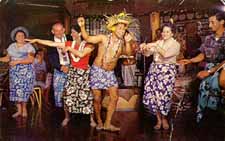
Questions?
Email us at: JandK@LivingGoldPress.com
 HOME
HOME

 |
Email us at: JandK@LivingGoldPress.com
|

|
Tiki Time© Jill Livingston |
 Who are these crazy people and what are they doing? As I browsed through a long box of cards looking to add to my (very humble) collection, this was a postcard that could not be ignored. I couldn't help but wonder just what had compelled these (presumably) normally staid and sober couples to wrap a length of bright tropical fabric over their suits and dressy dresses and around their ample middles, to whoop it up at the Bali Hai in San Diego circa 1960?
Who are these crazy people and what are they doing? As I browsed through a long box of cards looking to add to my (very humble) collection, this was a postcard that could not be ignored. I couldn't help but wonder just what had compelled these (presumably) normally staid and sober couples to wrap a length of bright tropical fabric over their suits and dressy dresses and around their ample middles, to whoop it up at the Bali Hai in San Diego circa 1960?
I'm pretty sure I now know what the motivation was,  and it came in a tall glass filled with some sort of rum and fruit concoction. Mundane jobs and PTA meetings quickly faded into a background haze after one was sated with roast pig, sticky sweet pseudopolynesian rice and vegetable dishes and one or two of those spectacular drinks served in special Tiki mugs. Joining in the fun at the nightly floor show was the natural next step, then "Waitress, bring me another one of those Mai Tais! And don't forget, you're invited to our backyard luau next weekend!"
and it came in a tall glass filled with some sort of rum and fruit concoction. Mundane jobs and PTA meetings quickly faded into a background haze after one was sated with roast pig, sticky sweet pseudopolynesian rice and vegetable dishes and one or two of those spectacular drinks served in special Tiki mugs. Joining in the fun at the nightly floor show was the natural next step, then "Waitress, bring me another one of those Mai Tais! And don't forget, you're invited to our backyard luau next weekend!"
And to think that all of this was going on just a few miles from where I lived and I knew nothing about it (being only eight or so). No matter. My postcard find sparked an interest in what might be called Tiki Culture.
Tiki Culture was a decades-long pop phenemonon that evolved over time but was something of a mishmash of fascination with things Hawaiian, beachcombing, exotic South Pacific tropical cultures (including food, clothing and art), and finally (in the later days) California style surfing.
Tiki was at its height in the 1950s and 1960s. Ukelele-strumming and beachcombing motif bar/restaurants were popular in the 30s and 40s. But I think it is safe to say that those responsible for bringing on the tropical fever were the returning WWII soldiers who had served their time in the Pacific. Their travels had exposed them to all things Polynesian. (Polynesia encompasses all of the islands in the Pacific from Hawaii to New Zealand.)
Shortly after the soldiers returned, Hawaii was opened up for tourist travel by jet travel, James Michener had best sellers such as Tales of the South Pacific and Hawaii, the adventure story of Kon Tiki was also a best seller, South Pacific was an immensely popular musical. (You know that song, "Some Enchanted Evening"? It is from the musical.)
 So the South Seas food, drink, music and decor morphed into something distinctly, flamboyantly American with little regard for authenticity. It first flowered in lush bars and restaurants such as Trader Vic's. Amid the tropical plants, rattan and bamboo there was likely a waterfall or stream, masks and spears on the walls. Burning torches, scantily clad waitresses, and all of the shenanagans were presided over by a large Tiki God, vaguely reminiscent of an Easter Island head. What a fantastic escape it must have been from the day-to-day grind.
So the South Seas food, drink, music and decor morphed into something distinctly, flamboyantly American with little regard for authenticity. It first flowered in lush bars and restaurants such as Trader Vic's. Amid the tropical plants, rattan and bamboo there was likely a waterfall or stream, masks and spears on the walls. Burning torches, scantily clad waitresses, and all of the shenanagans were presided over by a large Tiki God, vaguely reminiscent of an Easter Island head. What a fantastic escape it must have been from the day-to-day grind.
In the 1960s, everywhere you looked there was something "tiki". It was not only the themed restaurant/bars that carried the torch but also Disneyland (the Enchanted Tiki Room), motels, coffee shops, bowling alleys, shopping centers, apartment complexes, even trailer parks!
The trend went into decline in the 1970s and things Tiki rapidly disappeared or were shorn of their Island touches and so slipped into homogenous oblivion. But put on your urban archeologist eyeglasses and you might be surprised to find near where you live a long forgotten Bali Hai Trailer Court, the neon sign being the only evidence of its former distinction. Or a Kon Tiki Motel, the Tiki God banished but its A-frame roof and upswepted rafters clear proof that he does indeed still rule.
I've barely brushed the surface of this fine subject. Some people are true fanatical tiki collectors.
Items such as this drink mug from the restaurant featured on my postcard are auctioned daily on ebay.
Want to know more? Here is big beautiful colorful book that will tell you all about it.The Book of Tiki.
